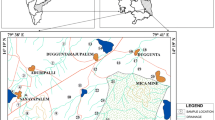Abstract
The study of hydrogeochemistry of the Mio-Pliocene sedimentary rock aquifer system in Veeranam catchment area produced a large geochemical dataset. Groundwater samples were collected at 52 sites over 963.86 km2 area and analyzed for major ions. The large number of data can lead to difficulties in the integration, interpretation and representation of the results. Two multivariate statistical methods, Hierarchical cluster analysis (HCA) and Factor analysis (FA), were applied to a subgroup of the dataset to evaluate their usefulness to classify the groundwater samples, and to identify geochemical processes controlling groundwater geochemistry. Hydrochemical data for 52 groundwater samples were subjected to Q- and R- mode factor and cluster analysis. R-mode analysis reveals the inter-relations among the variables studied and the Q-mode analysis reveals the inter-relations among the samples studied. The R-mode factor analysis shows that Ca, Mg and Cl with HCO3 account for most of the electrical conductivity, total dissolved solids and total hardness of groundwater. The ‘single dominance’ nature of the majority of the factors in the R-mode analysis indicates non-mixing or partial mixing of different types of groundwater. Both Q-mode factor and Q-mode cluster analyses indicate an exchange between the river water and the groundwater in the vicinity. The rock water interaction like flood basin back swamp deposits of silty clayey formation is the major cause for the cluster II classification. Cluster classification map reveals that 58% of the study area comes under cluster II classification.
Similar content being viewed by others
References
Adar, E.M., Rosenthal, E., Issar, A.S. and Batelaan, O. (1992) Quantitative assessment of the flow pattern in the southern Arava Valley (Israel) by environmental tracers and a mixing cell model. Jour. Hydrology, v.136, pp.333–352.
Danielsson, A., Cato, I., Carman, R. and Rahm, L. (1999) Spatial clustering of metals in the sediments of the Skagerrak/Kattegat. Applied Geochemistry, v.14, pp.689–706.
Eaton, E.M. (1950) Significance of carbonate in irrigation water. Soil Sci., v.69, pp.123–133.
Güler, C., Thyne, G.D., Mccray, J.E. and Turner, A.K. (2002) Evaluation of graph ical and multivariate statistical methods for classification of water chemistry data. Hydrogeology Jour., v.10, pp.455–474.
Helena, B., Pardo, B., Vega, M., Barrado, E., Fernandez, J.M. and Fernandez, L. (2000) Temporal evolution of groundwater composition in an alluvial aquifer (Pisuerga River, Spain) by rincipal component analysis. Water Res., v.34(3), pp.807–816.
Knudson, E.J., Duewer, D.L., Christian, G.D. and Larson, T.V. (1977) Application of factor analysis to the study of rain chemistry in the Puget Sound region. In: B.R. Kowalski (Ed.), Chemometric: Theory and Application. ACS Symposium Series, Washington, DC, pp.80–116.
Lambrakis, N., Antonakos, A. and Panagopoulos, G., (2004) The use of multicomponent statistical analysis in hydrogeological environmental research. Water Res., v.38, pp.1862–1872.
Panagopoulos, G., Lamprakis, N., Tsolis-Katagas, P. and Papoulis, D. (2004) Cation exchange processes and human activities in inconfined aquifers. Environ. Geol., v.46, pp.542–552.
Reghunath, R., Sreedhara, M.T.R. and Raghavan, B.R. (2002) The utility of multivariate statistical techniques in hydrogeochemical studies: an example from Karnataka, India. Water Res., v.36(10), pp.2437–2442.
Ribeiro, L. and Macedo, M.E. (1995) Application of multivariate statistics, trend and cluster analysis to groundwater quality in the Tejo and Sado aquifer. In: Groundwater Quality: Remediation and Protection. Proceedings of the Prague Conference, May 1995. IAHS Publ. No.225, pp.39–47.
Schot, P.P. and van Der Wal, J. (1992) Human impact on regional groundwater composition through intervention in natural flow patterns and changes in land use. Jour. Hydrology, v.134, pp.297–313.
Statsoft Inc. (2004) STATISTICA (Data Analysis Software System), Version 6.
Steinhorst, R.K. and Williams, R.E. (1985) Discrimination of groundwater sources using cluster analysis, MANOVA, canonical analysis and discriminant analysis. Water Resources Res., v.21, pp.1149–1156.
Suk, H. and Lee, K. (1999) Characterization of a ground water hydrochemical system through multivariate analysis: clustering into ground water zones. Ground Water, v.37(3), pp.358–366.
Vengosh, A. and Keren, R. (1996) Chemical modifications of groundwater contaminated by recharge of treated sewage effluent. Contam. Hydrol., v.23, pp.347–360.
Vincent Cloutier., René Lefebvre., René Therrien., Martine, M. and Savard. (2008) Multivariate statistical analysis of geochemical data as indicative of the hydrogeochemical evolution of groundwater in a sedimentary rock aquifer system Jour. Hydrology, v.353, pp.294–313.
Author information
Authors and Affiliations
Corresponding author
Rights and permissions
About this article
Cite this article
Suvedha, M., Gurugnanam, B., Suganya, M. et al. Multivariate statistical analysis of geochemical data of groundwater in Veeranam catchment area, Tamil Nadu. J Geol Soc India 74, 573–578 (2009). https://doi.org/10.1007/s12594-009-0170-1
Received:
Accepted:
Published:
Issue Date:
DOI: https://doi.org/10.1007/s12594-009-0170-1




